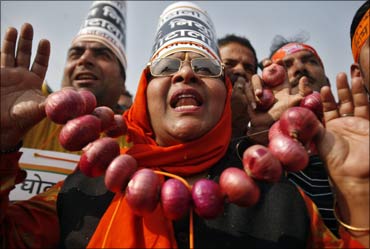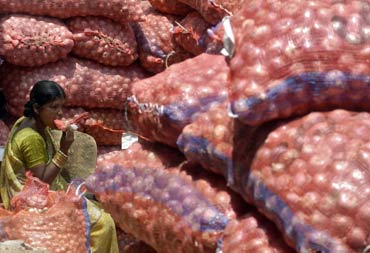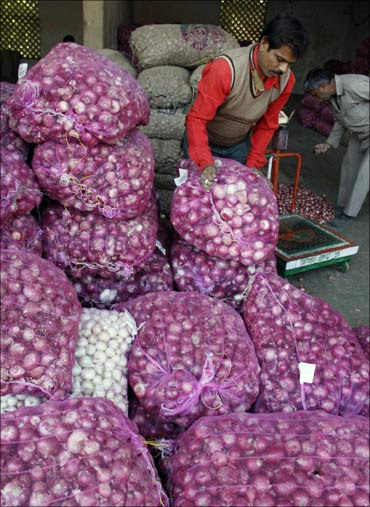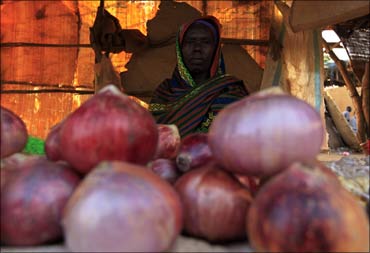Photographs: Reuters N Ganesh in Mumbai
If you think that the government's steps to import onions and ban their export will lead to any significant drop in onion prices, then you might be mistaken.
Farmers and agriculture experts say that onion prices are likely to rise further till the next Diwali.
Sometime from now till the next harvest, onions could totally disappear from the markets. And that is because the current crop has been largely damaged and the next crop is some months away.
This may dampen the spirits of onion-fans, but there is little that can be done than blame the current high prices on rain gods and greedy merchants who have been taking undue advantage of the situation.
However, the central government's diktat to the states to take hoarders to task could temper the prices somewhat.
Why has the price of onions skyrocketted?
"Unseasonal rains have caused havoc across the nation. Onion crop being sensitive to water has been damaged leading to the shortfall in supply and resulting in high prices," said Changdev Holkar, an onion farmer from Nashik in Maharashtra who is also a director at the National Agricultural Cooperative Marketing Federation of India.
. . .
Onion prices could remain high till next Diwali
Photographs: Reuters
The onions that are trickling into the market now are from the crop that was sown by the farmers at the onset of the monsoons. This year the monsoon extended well into the November and this was not conducive to harvesting of the onion crop, which mainly requires dry weather.
"Against the expected yield of 50 quintals (5,000 kg) per acre, I harvested less than half," said P R Gaikwad, an onion farmer from Phaltan near Satara in Maharashtra.
Gaikwad had sown onions in June and was expecting the harvest in October. "Usually the yield of onion is in the range of 50-100 quintal per acre for Kharif crop depending on the variety of onions. However, the actual yield turned out be 15-20 quintals only," rued Holkar.
The supply of onions to the APMC (Agricultural Produce Market Committee) at Vashi which is the nodal centre for the buying and selling of agricultural produce in the Mumbai region has been drastically dropping over the last two months.
"Normally 150-175 trucks loaded with onions arrive daily at the Vashi market which is sufficient to meet the demands of the Mumbai and the metropolitan regions. However, now merely 40-50 truckloads of onions have come to the market. This is less than 50 per cent of the demand and hence the prices have soared," said wholesale onion trader Sanjay Thorat.
. . .
Onion prices could remain high till next Diwali
Photographs: Reuters
He added that the current wholesale price was averaging at Rs 60 to Rs 70 per kg and the retail sellers have to bear additional Rs 30 for every sack of 50 kg for transportation to their destination.
"The quality of onions is also not very good and in every sack almost 10 kg of onions turn out to be damaged. All this leads to further escalation in the retail cost of onions," said Thorat.
The farmers rue that that it is the traders who are benefiting from the vast gulf in demand and supply.
"Only a little stock of onions has been getting a price of Rs 6,000-7,000 per quintal. The average price farmers are getting is in the range of Rs 2,000-3,000, whereas it is being sold at three times the cost by the traders," lamented Holkar.
Mumbai households cry out for onions
Aruna Parthasarathy, a teacher, has cut down on the consumption of onions. "Now I use onions sparingly, just for the aroma. I am prepared to entirely give up on them if prices rise any further," said Parthasarathy.
. . .
Onion prices could remain high till next Diwali
Photographs: Reuters
Darshana Ruparel, a homemaker, laments that despite soaring prices some of the onions available in the market are not of good quality.
"I have cut down on usage of onions. However, the cost of other vegetables too has soared so much that I am not very worried about onions which I use as a supplementary ingredient in cooking," said Ruparel.
For Lata Ganesh, a homemaker, it was sometime in the distant past that she liberally used onions in her cooking. Now onions in Lata's household are consumed sparingly.
"If the prices shoot up further we will be forced to adopt more stringent measures," said Lata. According to her the onion was considered to be poor man's food. "It is the poor who have been affected by the soaring prices. The government has to intervene," said Lata.
She has observed a certain pattern to the vegetable inflation, she says. "Once the price goes up it does not come down for the entire season," she remarked.
. . .
Onion prices could remain high till next Diwali
Photographs: Reuters
Extra helping of onions costs more at hotels
The next time you nonchalantly order an extra helping of raw onions be prepared to be charged extra. According to Narayan Alwa, president of AHAR (Association of Hotel and Restaurants) in Mumbai, extra helping of onions will cost more.
"Initially we did not want to pass the burden on to our customers but the costs kept on increasing and we have been forced to take this drastic step," said Alwa.
There are more than 8,000 hotels in Mumbai and most of them are affiliated to AHAR which means that a decision taken by the association would be applicable throughout Mumbai and adjoining regions.
What lies ahead?
Despite the government's move to ban exports and begin import of onion, most people believe there will be little or no impact on the soaring prices as the Kharif crop does not meet the export quality standards.
After a disastrous harvest, farmers sowed seeds in October-November for next cycle of summer crop and the exercise was rendered useless by the unseasonal rains.
. . .
Onion prices could remain high till next Diwali
Photographs: Reuters
"I gave up after all the seedlings were destroyed by unseasonal rains and delayed winter," said Gaikwad.
Other farmers, like Holkar, have been fortunate that only 10-15 per cent of seedlings from their nursery were damaged. Onion seeds are perishable and do not last for more than a year and this year due to poor crop there is huge shortage of sowing seeds in the market for the farmers.
"Onion seeds are not available even when farmers are ready to offer Rs 2,000 per kg compared to the normal rate of Rs 500 kg," said Holkar.
If there is less sowing now, it will result in lesser output in the next harvest cycle. "The summer crop which is harvested from April to June is the major source of onion supply. Besides sustaining the market till October it is also exported owing to its high quality as it has longer shelf life than the Kharif crop," explained Holkar.
Some farmers, like Gaikwad, have given up on onion cultivation as it is "very risky crop" and have chosen other crops.
"Onion being a sensitive crop its cultivation depends on a lot of factors and odds are always against the farmer," rued Gaikwad.







article